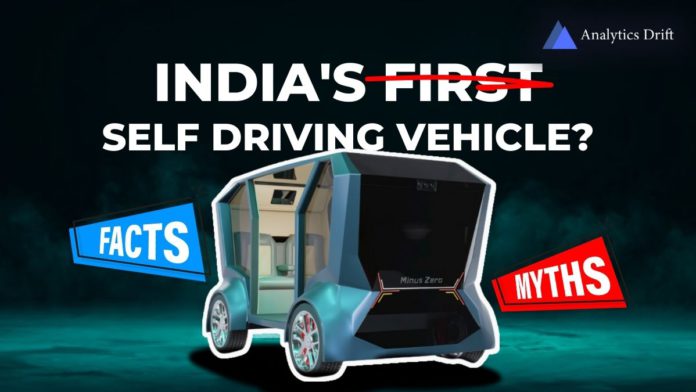Recently, Minus Zero, a Bengaluru-based autonomous driving start-up, unveiled the zPod, which it claims is India’s first autonomous vehicle. However, the claims are misleading as Minus Zero is not the first company in India to introduce autonomous vehicle technology. Minus Zero has not yet responded to our email concerning their claims.
The official website of the company Minus Zero says ‘The history was made 04.06.2023.’ It goes on to falsely claim that “While India experienced its first autonomous vehicle ride, the world witnessed True Vision Autonomy for the first time.”
Leading news outlets such as Economic Times, Business Today, and Hindustan Times have published news reports with headlines that explicitly describe Minus Zero’s claims of zPod being India’s first autonomous vehicle, whereas Financial Times, The Hindu, and Wion mention the startup’s claims on the same.
A funding news report published by Business Insider blatantly described Minus Zero as ‘India’s first self-driving car startup’. The report said, “India’s first startup building affordable fully self-driving cars in India has raised $1.7 million in seed round led by Chiratae Ventures.”
The zPod by Minus Zero claims to be an autonomous vehicle that uses its camera system to operate in any location and circumstance. The zPod is a four-seater electric vehicle with no controls or a dashboard like a typical car. Unlike many autonomous cars, the zPod uses a system of six cameras instead of LIDAR (light detection and ranging), with two in the front and back and four on the sides.
However, Swayatta Robots has already been using this technology for the past few years.
Founded in 2015, Swaayatt Robots has been focusing on fundamental research and application in reinforcement learning, motion planning, and algorithmic frameworks for autonomous vehicles that are capable of navigating highly stochastic traffic-dynamics, and can even function in unstructured Indian environments.
To enable autonomous vehicles to handle both stochastic and hostile traffic circumstances, the team has been using reinforcement learning (RL) to learn different navigation policies. For instance, their multi-RL agent system for intent analysis and negotiation enables autonomous vehicles to navigate congested, dynamic highways at both low and high speeds.
Read More: Vimeo Introduces AI-Powered Script Generator And Text-Based Video Editor
Swaayatt Robots has already created algorithmic frameworks for vision that enable autonomous vehicles to see both during the day and at night without the use of RADARs and LiDARs. In comparison to current state-of-the-art deep learning systems, its perception algorithms, based on end-to-end deep learning, are extremely computationally efficient.
About 2% of Swaayatt Robots research has been focused for years on making autonomous driving possible without the need for fidelity maps. To do away with high-fidelity maps, Sanjeev and his colleagues at Swaayatt Robots have created new algorithms in both perception and planning. Typically, businesses employ high-fidelity maps to project and generate delimiters since they are unable to create algorithms that are reliable enough to do so in real time. Therefore, Minus Zero is not the first to introduce this technology in its zPod, as shown in the videos.
The Swayatta Robots official website and YouTube have many videos that showcase the company testing its autonomous vehicle technology under various circumstances. Some of these videos are as old as six years, serving as proof of their research and testing. The company has also received accolades and funding for autonomous vehicle research and development.
In conclusion, it is clear that Minus Zero’s zPod claiming the title of India’s first autonomous vehicle undermines Swaayatt Robots’ years of research and development progress. Considering all the facts, there is no doubt that Swaayatt Robots is the only deserving startup to claim the honor.


